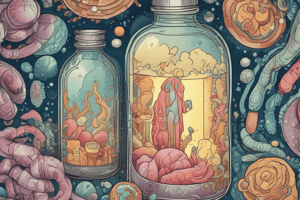Podcast
Questions and Answers
What are the reasons for natural resistance within bacteria?
What are the reasons for natural resistance within bacteria?
- Target not present- Mycoplasma sp has no cell wall. Lactobacillus sp. side chain in cell wall and glycopeptides cannot bind.
- Target not accessible- Vancomycin unable to penetrate Gram negative bacteria's outer membrane.
- Developmental structure/ state- C. difficile spore- persister cells and biofilms more resistant
- Metabolism- metronidazole uptake and action require anaerobic conditions.
What is the selection pressure in acquiring resistance?
What is the selection pressure in acquiring resistance?
Exposure to antibiotics in the environment encourages resistance as small numbers of ‘resistant mutants’ will survive whilst susceptible organisms die off
- Particularly likely to happen in the gut of someone taking antibiotics or in bacteria in a hospital environment
What gives the bacteria the ability to become resistant to an antibiotic?
What gives the bacteria the ability to become resistant to an antibiotic?
Change in bacterial DNA gives it the ability to become resistant to the antibiotic.
What are the two ways in which there is a change in bacterial DNA in situations of gaining resistance?
What are the two ways in which there is a change in bacterial DNA in situations of gaining resistance?
What are the three ways of transfer of bacterial DNA?
What are the three ways of transfer of bacterial DNA?
What are the mechanisms of resistance within bacteria?
What are the mechanisms of resistance within bacteria?
What is the resistance mechanism of altered permeability?
What is the resistance mechanism of altered permeability?
What is the resistance mechanism pertaining to inactivation through enzymes?
What is the resistance mechanism pertaining to inactivation through enzymes?
What are some examples of Beta lactamase inhibitors?
What are some examples of Beta lactamase inhibitors?
What are some examples of beta lactamases?
What are some examples of beta lactamases?
What is the resistance mechanism of drug target modification?
What is the resistance mechanism of drug target modification?
Flashcards are hidden until you start studying





